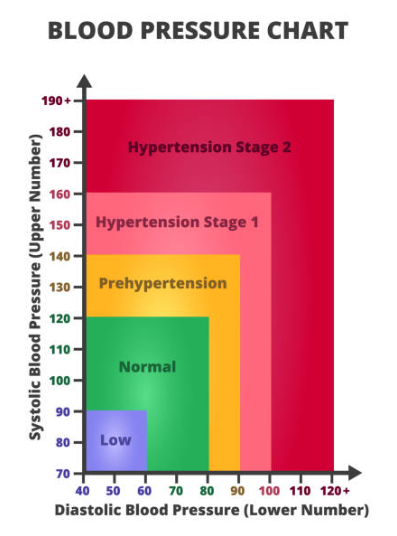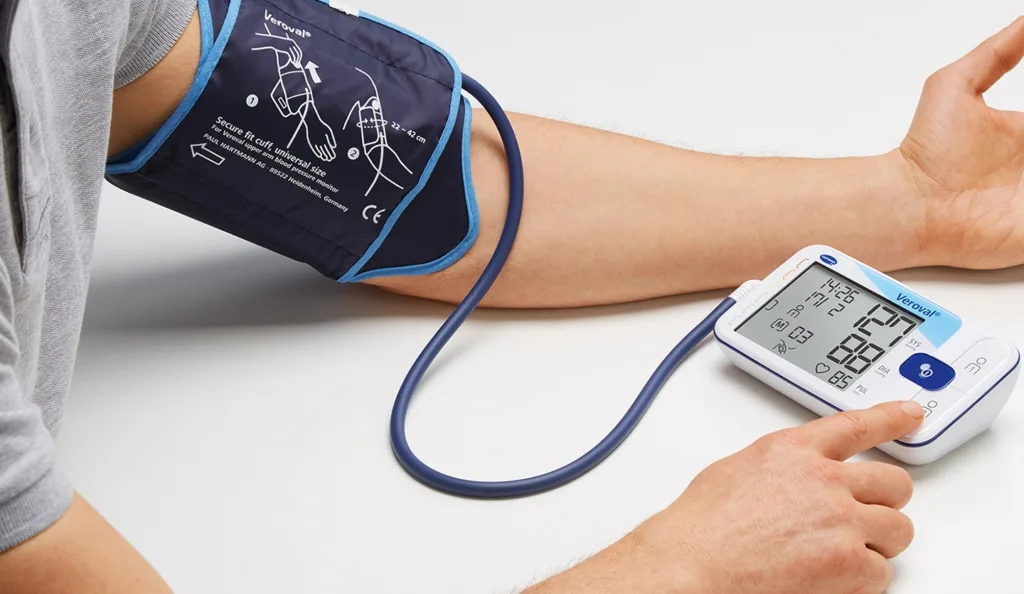
Your blood pressure reading is an important pair of numbers that can indicate your risk of heart attack and stroke. It can be measured with a home blood pressure monitor, or through your GP or local pharmacy.
What Blood Pressure Readings Mean
When you have your blood pressure taken, the result will be two numbers, for example 140/80mmHg. Hg is the chemical symbol of Mercury, because the traditional method involved measuring the millimetres (mm) of Mercury in a tube. Most devices don’t use Mercury, but still give results in mmHg as these are the standard units.
The numbers are as follows:
- Systolic pressure: This is the first number, and it’s the force at which your heart pumps blood around your body
- Diastolic pressure: This is the second number, representing the pressure in your arteries between heartbeats, and it is always the lower of the two.
Blood pressure charts like the one below are very common. While they are good for general understanding they may miss important differences due to age and sex.

A review article [1] found that blood pressure is higher in men than in women at similar ages. However, after menopause, blood pressure increases in women and ends up being higher than similarly aged men.
As for age, you will see guidelines that show the normal range increasing steadily with age, from 18 to 64. This may be because the entire population has some form of elevated blood pressure. One study on a South American tribe with no access to a Western diet found that blood pressure was remarkably consistent at all ages [2].
With that in mind, we can simply consider the latest AHA guidelines when determining a healthy blood pressure. Note that “hypertension” is the medical term for high blood pressure:
- Normal blood pressure: 120 or lower / 80 or lower
- Elevated blood pressure: 120 to 129 / 80 or lower
- Hypertension Stage 1: 130 to 139 / 80 to 89
- Hypertension Stage 2: 140 or higher / 90 or higher
It’s possible that your systolic (first number) is in one category, and the diastolic (second number) is in another. Ultimately, anything above 120/80 is something you should discuss with your doctor.
How To Measure Blood Pressure
If you are concerned that your blood pressure is high, you can see a GP and ask them to check. In the UK, those over the age of 40 may be able to get a free blood pressure check at a local pharmacy.

While they can be symptoms of other conditions, very high blood pressure can cause shortness of breath, dizziness, chest pain, headaches, nosebleeds and blurred vision. However, it’s far more common to have high blood pressure without any of these symptoms.
Many companies now sell an at-home blood pressure cuff and monitor. These are usually electronic, meaning you can get a blood pressure reading at the press of a button. The British Heart Foundation website has a shop which stocks reliable brands, including Omron, A&D and Microlife. The NHS recommends devices for the upper arm, rather than finger or wrist machines.

There’s several considerations to make in order to get the best possible reading:
- Avoid eating, smoking or vigorous exercise beforehand: Doing any of these in the 30 minutes before a blood pressure measurement can give elevated readings.
- Wear an appropriately sized cuff: Ideally you would measure your upper arm and buy the correct cuff size. Most blood pressure monitors are sold with a Medium cuff (22-32cm). If you arm is particularly large or small, you may need to buy a different cuff. This is important as an ill-fitting cuff can lead to inaccurate results
- Sit upright in a chair with back support: The extra effort of supporting yourself in a seated position can increase your blood pressure at rest. Additionally, have your feet flat on the floor and forearm on a surface you can rest it on naturally.
- Avoid clothing on the upper arm: The cuff should be placed directly on bare skin for the most accurate values.
- Relax: It’s a good idea to be seated for several minutes before taking a reading. Try to breathe normally and avoid talking or excessive movement. If necessary, you can ask someone else to press the start button for you.
- Measure both arms: Some cardiovascular issues can lead to significantly different readings between arms. If a number seems incorrect, it’s also good practice to measure that same arm again several minutes later.
- Measure on several, non-consecutive days: Your blood pressure can vary day to day, due to things like exercise and stress. By measuring on non-consecutive days, for example Monday, Wednesday and Friday, it gives a more accurate assessment of the true value.
Below is a short video demonstration of a blood pressure reading using an at-home monitor.
How Do I Lower My Blood Pressure?
There are several lifestyle factors increase your chance of high blood pressure. These include a diet high in salt, smoking, drinking lots of alcohol or caffeine, a sedentary lifestyle and being overweight or obese.

Therefore, to lower your blood pressure, you can do the following:
- Reduce the amount of salt in your diet
- Stop smoking
- Reduce the amount of alcohol in your diet
- Reduce the amount of caffeine in your diet
- Increase the amount of exercise you do
- Lose excess fat
How Often Should I Measure My Blood Pressure?
This varies greatly by your initial results. If you are healthy and in range, once a year is a great starting point. You would need to reduce this to every 3 to 6 months if you have elevated blood pressure. Those with high blood pressure should speak to their GP, who may advise weekly measurements until it’s under control.
References
[1] Gender Differences in the Regulation of Blood Pressure, J. Reckelhoff 2001
[2] Association of Age With Blood Pressure Across the Lifespan in Isolated Yanomami and Yekwana Villages, N.Mueller, O.Noya-Alarcon, M.Contreras et al. 2018

